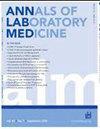Effect of Variability on Interferon-Gamma Release Assay Performance: A Quantitative Analysis.
IF 3.9
2区 医学
Q1 MEDICAL LABORATORY TECHNOLOGY
引用次数: 0
Abstract
Interferon-gamma release assays (IGRAs) are widely used to identify latent tuberculosis infection (LTBI); however, inherent test variability affects their diagnostic interpretation. We evaluated false-positive and false-negative rates, as well as conversion and reversion rates across CVs of 20%, 40%, 60%, 80%, and 100%, using statistical modeling. At a diagnostic cutoff of 0.35 IU/mL, false-negative rates increased from 1.61% to 33.41% with increasing CVs, whereas false-positive rates ranged from 0.00% to 15.87% within the 0.20-0.70 IU/mL borderline range. Expanding the borderline to 0.20-1.00 IU/mL reduced false-positive rates to a maximum of 3.16%, without affecting false-negative rates. Within the 0.20-0.70 IU/mL borderline zone, correct reversion and false conversion rates at 0.20 and 0.35 IU/mL ranged from 0.01% to 25.00% and 0.00% to 24.20%, respectively. At 0.35, 0.70, and 1.00 IU/mL, correct conversion and false reversion rates ranged from 0.05% to 24.20% and 0.00% to 25.00%, respectively. These results highlight the importance of adopting borderline zones in IGRA interpretation to reduce misclassification, although variability from manufacturing, pre-analytical processing, and analytical procedures remains a significant challenge. Reducing such variability through improved production consistency, standardized sample handling, and automated analysis platforms is essential to enhance the diagnostic reliability of IGRAs for LTBI.变异对干扰素释放试验性能的影响:定量分析。
干扰素γ释放试验(IGRAs)被广泛用于鉴定潜伏性结核感染(LTBI);然而,固有的测试可变性影响其诊断解释。我们使用统计模型评估了假阳性和假阴性率,以及cv中20%、40%、60%、80%和100%的转换和逆转率。在诊断截止值为0.35 IU/mL时,随着cv的增加,假阴性率从1.61%增加到33.41%,而在0.20-0.70 IU/mL的临界值范围内,假阳性率从0.00%增加到15.87%。将临界值扩大到0.20-1.00 IU/mL,在不影响假阴性的情况下,将假阳性率降低到最高3.16%。在0.20 ~ 0.70 IU/mL交界区,0.20和0.35 IU/mL的正确还原率和错误转化率分别为0.01% ~ 25.00%和0.00% ~ 24.20%。在0.35、0.70和1.00 IU/mL时,正确转化率为0.05% ~ 24.20%,错误转化率为0.00% ~ 25.00%。这些结果强调了在IGRA解释中采用边界区域以减少错误分类的重要性,尽管制造、分析前处理和分析程序的差异仍然是一个重大挑战。通过提高生产一致性、标准化样品处理和自动化分析平台来减少这种可变性,对于提高IGRAs诊断LTBI的可靠性至关重要。
本文章由计算机程序翻译,如有差异,请以英文原文为准。
求助全文
约1分钟内获得全文
求助全文
来源期刊

Annals of Laboratory Medicine
MEDICAL LABORATORY TECHNOLOGY-
CiteScore
8.30
自引率
12.20%
发文量
100
审稿时长
6-12 weeks
期刊介绍:
Annals of Laboratory Medicine is the official journal of Korean Society for Laboratory Medicine. The journal title has been recently changed from the Korean Journal of Laboratory Medicine (ISSN, 1598-6535) from the January issue of 2012. The JCR 2017 Impact factor of Ann Lab Med was 1.916.
 求助内容:
求助内容: 应助结果提醒方式:
应助结果提醒方式:


